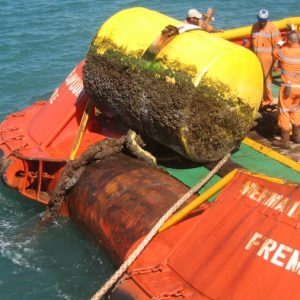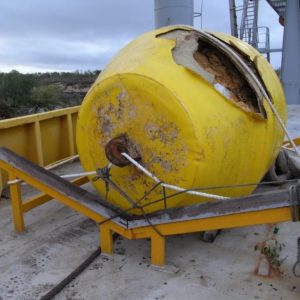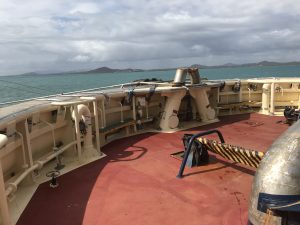December 16, 2019
Cyclone moorings hold vessels safely on station throughout the most extreme of Australian storm events. That is a big ask and raises many issues.
It would be a huge contribution to constructive discussion if the number of incidents related to their use, misuse and failures were freely available, but I can’t see port authorities nor insurance companies making that information available for some time.
Cyclone moorings are problematic because there are many conflicting engineering opinions and practical challenges all rolled up into the one situation. Design, installation, operation and maintenance are all challenging from different perspectives. Most initiatives to drive the consistency in cyclone mooring design and operation happened at the behest of port authorities in Western Australia such as Pilbara and Kimberley Ports. It started about 20 years ago with expansion of the marine industry and moorings in Dampier. The then Dampier Port Authority commissioned Worley Ports and Harbour Consultants to produce guidelines: Vessel Cyclone Moorings – Critical Aspects for Consideration by Vessel Owners and Operators. The guidelines were well formulated and fit for purpose but with commercial pressures, changes in mooring analysis tools and the use of mooring stretchers – challenges re-emerged.



The cyclone mooring concept is for an omni directional mooring whereby the moored vessel can weathervane around a fixed point on the sea floor. This allows the loads to remain low due to the minimal exposure of the vessel to environmental loads. The moorings, known as admiralty moorings, were used for many years and likely its origin is in naval vessel moorings. They comprise three ground legs spreading radially so that for any orientation of the vessel hanging off the mooring riser, the load is no greater than that on a single leg with aligned directional loading.
Most cyclone moorings are anchored with a drag embedment anchor providing great potential holding capacity. The holding capacity of the mooring can only be realised by substantial embedment. Proof loading of the anchor adequately is often compromised by limited installation budget, availability of suitable vessels or lack of understanding of the risk in not proof loading. It is assumed that with minimal installation embedment any ground leg loading will automatically increase embedment and holding capacity. For this reason, we recommend clients give a cyclone mooring a substantial pull before renting to prove the veracity of nominated capacities. Often this results in slippage suggesting proof loading was not adequately completed or circumstances have changed since installation. In some cases, a visual inspection by divers or ROV will show incorrect or inadequate embedment. So, a cyclone mooring should be treated like taking a tug on hire, that is, you need to check the appropriate bollard pull (capacity) or certification. A failed cyclone mooring has a high potential for putting lives at risk and appropriate, demonstrable checks and balances must be in place.
Operators of cyclone moorings were also quick to understand cyclone mooring loads were highly dynamic and the stiffer the hawser the higher the load. The damping of the vessels motions was highly beneficial in reducing mooring loads and the likelihood of failure. The early mooring design calculations were static approaches which included a dynamic factor and were based on BS6349 Part 6: Design of Inshore Moorings and Floating Structures. The standard provided insight into the application of loads but fell short as cyclone moorings are subject to offshore wave and extreme conditions. The approach was static, dynamic factors were subjective and therefore the analytical benefits of stretchers could not be readily demonstrated.


